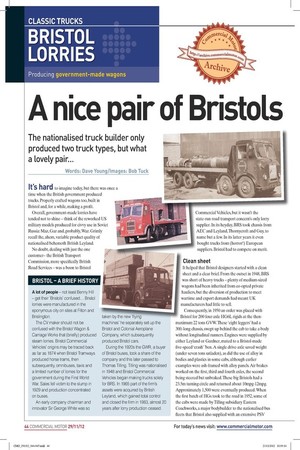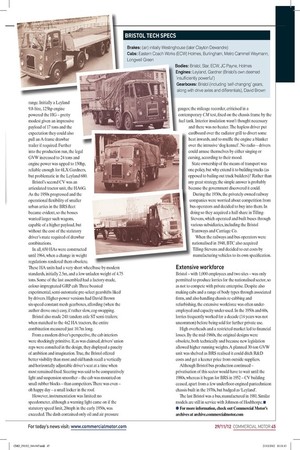A nice pair of Bristols
Page 38

Page 39

If you've noticed an error in this article please click here to report it so we can fix it.
The nationalised truck builder only produced two truck types, but what a lovely pair...
Words: Dave Young/Images: Bob Tuck It’s hard to imagine today, but there was once a time when the British government produced trucks. Properly crafted wagons too, built in Bristol and, for a while, making a profit.
Overall, government-made lorries have tended not to shine – think of the reworked US military models produced for civvy use in Soviet Russia: Maz, Gaz and, probably, Waz. Grimly recall the, ahem, variable product quality of nationalised behemoth British Leyland.
No doubt, dealing with just the one customer– the British Transport Commission, more specifically British Road Services – was a boon to Bristol Commercial Vehicles, but it wasn’t the state-run road transport concern’s only lorry supplier. In its heyday, BRS took chassis from AEC and Leyland, Thornycroft and Guy, to name but a few. In its latter years it even bought trucks from (horror!) European suppliers. Bristol had to compete on merit.
Clean sheet
It helped that Bristol designers started with a clean sheet and a clear brief. From the outset in 1948, BRS was short of heavy trucks – plenty of medium-sized wagons had been inherited from co-opted private hauliers, but the diversion of production to meet wartime and export demands had meant UK manufacturers had little to sell.
Consequently, in 1950 an order was placed with Bristol for 200 four-axle HG6L rigids at the thenmaximum 22 tons GVW. These ‘eight leggers’ had a 30ft-long chassis, swept up behind the cab to take a body without longitudinal runners. Engines were supplied by either Leyland or Gardner, mated to a Bristol-made five-speed ‘crash’ ’box. A single drive-axle saved weight (under seven tons unladen), as did the use of alloy in bodies and plastics in some cabs, although earlier examples were ash-framed with alloy panels. Air brakes worked on the first, third and fourth axles, the second being steered but unbraked. These big Bristols had a 23.5m turning circle and returned about 10mpg-12mpg. Approximately 1,500 were eventually produced. When the first batch of HGs took to the road in 1952, some of the cabs were made by Tilling subsidiary Eastern Coachworks, a major bodybuilder to the nationalised bus fleets that Bristol also supplied with an extensive PSV range. Initially a Leyland 9.8-litre, 125hp engine powered the HG – pretty modest given an impressive payload of 17 tons and the expectation they could also pull an A-frame drawbar trailer if required. Further into the production run, the legal GVW increased to 24 tons and engine power was upped to 150hp, reliable enough for 6LX Gardners, but problematic in the Leyland 680.
Bristol’s second CV was an articulated tractor unit, the HA6G.
As the 1950s progressed and the operational flexibility of smaller urban artics in the BRS fleet became evident, so the bosses wanted larger such wagons, capable of a higher payload, but without the cost of the statutory driver’s mate required of drawbar combinations.
In all, 650 HAs were constructed until 1964, when a change in weight regulations rendered them obsolete.
These HA units had a very short wheelbase by modern standards, initially 2.5m, and a low unladen weight of 4.75 tons. Some of the last assembled had a factory-made, colour-impregnated GRP cab. Three boasted experimental, semi-automatic pre-select gearshifts liked by drivers. Higher-power versions had David Brown six-speed constant mesh gearboxes, affording (when the author drove one) easy, if rather slow, cog-swapping.
Bristol also made 24ft tandem axle ST semi-trailers; when matched to the 4x2 HA tractors, the entire combination measured just 10.7m long.
From a modern driver’s perspective, the cab interiors were shockingly primitive. If, as was claimed, drivers’ union reps were consulted in the design, they displayed a paucity of ambition and imagination. True, the Bristol offered better visibility than most and old hands recall a vertically and horizontally adjustable driver’s seat at a time when most remained fixed. Steering was said to be comparatively light and suspension smoother – the cab was mounted on small rubber blocks – than competitors. There was even – oh happy day – a small locker in the roof.
However, instrumentation was limited: no speedometer, although a warning light came on if the statutory speed limit, 20mph in the early 1950s, was exceeded. The dash contained only oil and air pressure gauges; the mileage recorder, criticised in a contemporary CM test, fixed on the chassis frame by the fuel tank. Interior insulation wasn’t thought necessary and there was no heater. The hapless driver put cardboard over the radiator grill to divert some heat inwards, and to muffle the engine a blanket over the intrusive ‘dog kennel’ . No radio – drivers could amuse themselves by either singing or cursing, according to their mood.
State ownership of the means of transport was one policy, but why extend it to building trucks (as opposed to bailing out truck builders)? Rather than any great strategy, the simple answer is probably because the government discovered it could. During the 1930s, the privately owned railway companies were worried about competition from bus operators and decided to buy into them. In doing so they acquired a half share in TillingStevens, which operated and built buses through various subsidiaries, including the Bristol Tramways and Carriage Co.
When the railways and bus operators were nationalised in 1948, BTC also acquired Tilling-Stevens and decided to cut costs by manufacturing vehicles to its own specification.
Extensive workforce
Bristol – with 1,000 employees and two sites – was only permitted to produce lorries for the nationalised sector, so as not to compete with private enterprise. Despite also making cabs and a range of body types through associated firms, and also handling chassis re-cabbing and refurbishing, the extensive workforce was often underemployed and capacity under-used. In the 1950s and 60s, lorries frequently worked for a decade (14 years was not uncommon) before being sold for further private use.
High overheads and a restricted market led to financial losses. By the mid-1960s, the original designs were obsolete, both technically and because new legislation allowed higher running weights. A planned 30-ton GVW unit was shelved as BRS realised it could ditch R&D costs and get a keener price from outside suppliers.
Although Bristol bus production continued – privatisation of this sector would have to wait until the 1980s, whereas it began for BRS in 1952 – CV building ceased, apart from a few underfloor-engined pantechnicon chassis built in the 1970s, but badged as ‘Leyland’.
The last Bristol was a bus, manufactured in 1981. Similar models are still in service with Johnson of Hodthorpe. n ● For more information, check out Commercial Motor’s archives at archive.commercialmotor.com
BRISTOL A BRIEF HISTORY
A lot of people – not least Benny Hill – get their ‘Bristols’ confused... Bristol lorries were manufactured in the eponymous city on sites at Filton and Brislington.
The CV maker should not be confused with the Bristol Wagon & Carriage Works that (briefly) produced steam lorries. Bristol Commercial Vehicles’ origins may be traced back as far as 1874 when Bristol Tramways produced horse trams, then subsequently, omnibuses, taxis and a limited number of lorries for the government during the First World War. Sales fell victim to the slump in 1929 and production concentrated on buses.
An early company chairman and innovator Sir George White was so taken by the new ‘flying machines’ he separately set up the Bristol and Colonial Aeroplane Company, which subsequently produced Bristol cars.
During the 1920s the GWR, a buyer of Bristol buses, took a share of the company and this later passed to Thomas Tilling. Tilling was nationalised in 1948 and Bristol Commercial Vehicles began making trucks solely for BRS. In 1965 part of the firm’s assets were acquired by British Leyland, which gained total control and closed the firm in 1983, almost 20 years after lorry production ceased.
BRISTOL TECH SPECS
Brakes: (air) initially Westinghouse (later Clayton Dewandre) Cabs: Eastern Coach Works (ECW) Holmes, Burlingham, Metro Cammell Weymann, Longwell Green Bodies: Bristol, Star, ECW, JC Payne, Holmes Engines: Leyland, Gardner (Bristol’s own deemed ‘insufficiently powerful’) Gearboxes: Bristol (including ‘self-changing’ gears, along with drive axles and differentials), David Brown













































